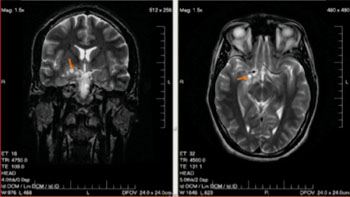Familial Glioma Linked to Mutation in Telomere Protection Gene
By LabMedica International staff writers
Posted on 15 Dec 2014
Mutations in the POT1 (protection of telomeres protein 1) gene have been linked to the development of brain tumors in families with two or more members suffering from glioma, the most common form of primary brain cancer.Posted on 15 Dec 2014
The POT1 gene is a member of the shelterin complex and encodes a nuclear protein involved in telomere maintenance. Specifically, this protein functions as a member of a multiprotein complex that binds to the TTAGGG repeats of telomeres, regulating telomere length and protecting chromosome ends from illegitimate recombination, catastrophic chromosome instability, and abnormal chromosome segregation.

Image: Two MRI images of low-grade brain glioma in a 28-year-old male (Photo courtesy of Wikimedia Commons).
A recent paper described a study that was conducted under the auspices of the Gliogene Consortium (Houston, TX, USA), a collaborative group of familial brain tumor researchers from the United States, the United Kingdom, Sweden, Denmark, and Israel. Between 2007 and 2011 The Gliogene Consortium recruited 435 families in which glioma occurred in multiple family members. Overall, it has been estimated that approximately 5% of brain tumors are familial.
Whole exome sequencing (which determines the DNA sequence of the exons, or protein-coding regions, of tens of thousands of genes simultaneously) was performed on samples taken from 90 individuals with glioma from this group.
Results identified two families presenting with mutations in POT1 that were shared by both affected individuals in each family. Validation in a separate cohort of 264 individuals from 246 families identified an additional mutation in POT1. In one family, six members carried a POT1 mutation that is rarely found in normal populations, and among them three developed glioma. In another family, six individuals carried a different POT1 gene mutation and two developed glioma.
At the molecular level the POT1 mutations were predicted to impact DNA and TPP1 binding. TPP1 normally interacts with POT1 and regulates its function. When telomeres are to be lengthened, TPP1 is a central factor in recruiting telomerase to telomeres.
"I have been researching familial glioma for nearly 30 years, and this study is really the first time we have had a hit when it comes to identifying a gene that is potentially associated with predisposition to the disease," said senior author Dr. Melissa Bondy, professor of medicine at Baylor College of Medicine (Houston, TX, USA) and principal investigator of the Gliogene Consortium.
"It is widely thought amongst the clinical community that there is no association between family history and development of glioma. Because we know very little about the contributing genetic factors, when cases occur in two or more family members, it is viewed as coincidental," said Dr. Bondy. "By understanding more about the genetic link, we hope that one day we can improve treatments and preventive strategies for those with a family history of glioma."
The study will be published in the January 2015 online issue of the Journal of the [US] National Cancer Institute.
Related Links:
Gliogene Consortium
Baylor College of Medicine













.jpg)